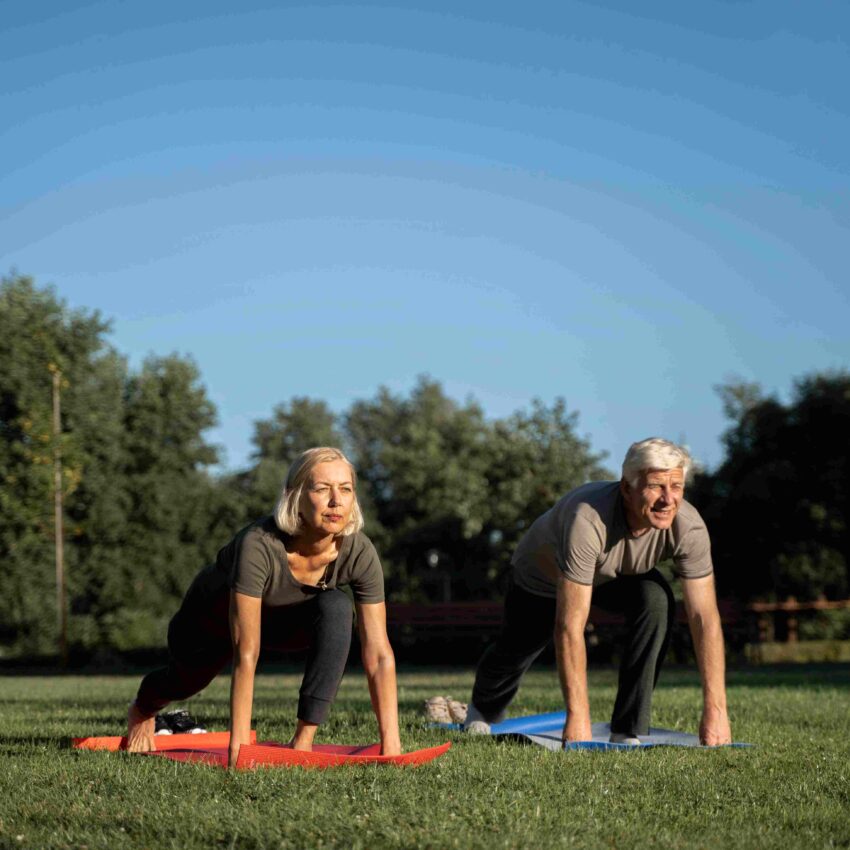Best Mobility Exercises for Seniors to Improve Flexibility
As we age, it is common to experience changes in our physical function. Older people might have trouble doing simple things they used to easily, like bending over or reaching for something high up. These kinds of physical challenges can be due to decreased flexibility, increased joint stiffness, or tight muscles. The good news is that mobility work and staying active can help seniors keep their range of motion, balance, and flexibility intact or even enhance them with these exercises for seniors.
In this article, we will review the exercises that seniors can practice for the best mobility. These exercises for seniors are not strenuous, generally safe, and effective in preserving functional abilities and overall health.
Why are Mobility Exercises for Seniors Important?
Mobility exercises are designed to maintain or improve the range of motion within your joints and muscles. They help you move more easily, and help protect against injury (like falls). Here are a few other benefits of these exercises for seniors:
- Improved flexibility: It makes it easier to do the things you need to move your body, from reaching something on a high shelf to bending to tying your shoes.
- Joint stiffness reduces: Promoting movement ensures that the joints are healthy and functional.
- Better balance: Helps prevent falls by improving stability.
- Increased blood circulation: Boosts energy and promotes healthy muscles.
Again, it is important to point out that mental well-being—One of the advantages of staying active is that it can help you decrease stress and maintain a good mood.
There are a few simple and effective mobility exercises for seniors to follow daily.
Warm-Up: Start with Light Movements
Before you start the mobility exercises, it’s essential to warm up. A light 5-10-minute warm-up gets your blood flowing and helps prepare your muscles for exercise.
Best warm-up exercises for Seniors they can do easily:
Marching in place – Lift knees one at a time, slowly and steadily.
Arm circles – This can be done by raising your arms to the side and making some small circles.
Neck rolls – Tilt your head to one side and slowly roll it forward and around to the other shoulder, then continue in the other direction.
After warming up, these are the best mobility exercises for seniors.
Best mobility exercises for seniors!
-
Ankle Circles (for Ankle Mobility and Balance)
Reason: The ankle’s mobility is vital for walking stability and balance. Weak or stiff ankles may cause an individual to have poor stability, which in turn increases the likelihood of falls.
How to Perform:
– Sit comfortably on a chair with your feet resting flat on the floor.
– Raise one foot slightly above the ground.
– Rotate your ankle 10 times in one direction, then switch and rotate it 10 times in the opposite direction.
– Switch to the other foot.
Tip: If sitting is easy for you, you can perform this exercise while you are standing by holding a chair with one hand and placing the other hand on your hip.
-
Shoulder Rolls (for Upper Body Flexibility)
Why: This helps to loosen the shoulders and upper back and improve your posture, making movements like lifting or reaching easier.
How to Perform:
– You may either sit or stand and let your arms hang down at your sides.
– Move your shoulder in a circular motion: lift it up and back, then lower it down and forward.
– Complete 10 circles, then switch and repeat in the opposite direction.
Tip: Do this exercise a few times each day to help ease tight shoulders.
-
Cat-Cow Stretch (for Spine Mobility)
Why: This easy move loosens up your spine and helps ease tension in your back, neck, and shoulders.
How to Perform:
– Take a chair or come down on the floor in all fours.
– Start by gently arching your back (Cow Pose) while raising your head and chest.
– Then you reverse the curve (Cat Pose) by tucking your chin to your chest and pulling your belly button up.
– Repeat 5-10 times in a slow, controlled motion.
When moving slowly, you prevent the stress from being put on your back, particularly if you are one of those persons in question.
-
Seated Hip Circles (for Hip Flexibility)
Hip mobility is important for comfortable walking, standing and bending. This exercise helps to loosen your hip joints.
How to Perform:
Sit down, put your feet on the floor, and cross your arms.
– Move your weight in a circular motion i.e. your hips should draw a circle.
Just do 10 circles in one direction and then the other.
Tip: Depending on what you’re comfortable with you can make the circles bigger or smaller.
-
Hamstring Stretch (for Leg Flexibility)
Why: The hamstring muscles in the back of the thighs tend to tighten up, and that can affect flexibility and make you more prone to falls.
How to Perform:
– Sit on the edge of a chair and extend one leg straight out in front, resting your heel on the floor.
– Lean forward from your hips until you feel a stretch along the back of the extended leg.
– Hold the stretch for 20-30 seconds, then switch to the other leg.
Keep your back straight, and don’t bounce; this puts undue stress on the muscle.
-
Chest Opener (for Upper Body Mobility)
Why: This stretch helps improve posture by opening up the chest muscles, which get tight from sitting too long.
How to Perform:
– Stand or sit upright.
Clasp your hands together behind you or put your hands on your lower back.
– Pull your hands/ elbows back gently, while opening up the chest.
– Hold for 20-30 seconds.
Tip: Breathe deeply while holding the stretch to release tension.
-
Toe Taps (for Leg and Ankle Mobility)
Why: Toe taps work on leg strength and ankle flexibility while also helping with coordination.
How to Perform:
– Be seated while the feet are kept flat on the floor.
– Lift your toes off the ground without lifting your heels and then tap them back onto the floor.
– Repeat 10-15 times.
Tip: This exercise can also be performed while standing.
-
Side Leg Raises (for Hip and Balance Improvement)
Why: This move will strengthen the hips and improve balance and stability.
How to Perform:
– Stand behind a chair, using it for support.
– Lift one leg out to the side as high as comfortably possible, keeping it straight.
– Lower the leg and repeat 10 times, then switch to the other leg.
Tip: Keep your movements slow and controlled for better results.
-
Seated Torso Twists (for Core Flexibility)
Why: Torso twists increase overall core flexibility and help keep the spine mobile, which is important for everyday movements.
How to Perform:
– Sit on a chair with your feet planted flat on the ground.
– Place your hands on your knees.
– Twist your upper body slightly to the right, pause for a second, then do it to the left.
– Repeat 10 times on each side.
Tip: Keep your movements slow and controlled so you don’t strain anything.
-
Standing Calf Stretch (for Lower Leg Flexibility)
This is the last but not least exercise for seniors.
Why: This stretch helps to maintain flexible calf muscles and prevents stiffness, which is important for walking and balance.
How to Perform:
– Stand facing a wall with your hands pressed against it.
– Step one foot back, pressing the heel into the ground while keeping the back leg straight.
– Hold the stretch for 20-30 seconds, then switch to the other leg.
Tip: Make sure that only the back heel remains on the ground to feel the stretch properly.
How Often Should Seniors Perform Mobility Exercises?
Seniors should perform these exercises 3-5 times a week. Each session should last 20-30 minutes. Remember to listen to your body and avoid pushing through any pain or discomfort.
Final Thoughts
The ability to maintain mobility and flexibility as you age can truly make a difference in the lives of seniors. Seniors will be able to move joints through their full range, perform day-to-day activities with greater ease, significantly reduce the risk of falls, and ultimately improve their quality of life with the help of mentioned exercises for seniors.
It’s never too late to start! Whether sitting or standing, there are safe, effective exercises for seniors that cater to different fitness levels. By staying consistent, seniors can stay active, and independent and feel their best at any age.


